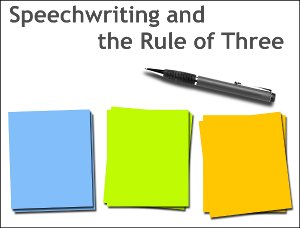by Andrew Dlugan
(The Study of Threes)
http://threesology.org


Your guide to a confident and effective speaker | |

Andrew Dlugan is the
editor and founder of Six Minutes. He teaches courses, leads seminars, coaches
speakers, and strives to avoid Suicide by PowerPoint. He is an award-winning public
speaker and speech evaluator. Andrew is a father and husband who resides in British
Columbia, Canada. | |
by Andrew Dlugan
May 27th, 2009
 The rule of three is powerful speechwriting
technique that you should learn, practice, and master.
The rule of three is powerful speechwriting
technique that you should learn, practice, and master.Using the Rule of Three allows you to express concepts more completely, emphasize your points, and increase the memorability of your message.
That’s the truth, the whole truth, and nothing but the truth.
What is the rule of three? What are some famous examples? How do you use it in speeches? Read on!
Article Series
Western Culture and the Rule of Three
Trios, triplets, and triads abound in Western culture in many disciplines. Just a small sampling of memorable cultural triads include:
- Christianity
- Father, Son, and Holy Spirit
- Heaven, hell, and purgatory (Catholicism, primarily)
- Three Wise Men with their gold, frankincense, and myrrh
- Movies & Books
- The Good, the Bad, and the Ugly
- Sex, Lies, and Videotape
- Superman’s “Truth, Justice, and the American Way“
- Nursery rhymes such as the Three Little Pigs or Goldilocks and the Three Bears
- In a more general sense, there is the allure of trilogies as with:
- Indiana Jones
- The Godfather
- The Matrix
- Star Wars
- and many others.
- Politics
- U.S. Branches of Government: Executive, Judicial, and Legislative
- U.S. Declaration of Independence: “Life, liberty, and the pursuit of happiness”
- French motto: Liberté, Égalité, Fraternité
- Abundance of tri-colored flags
- Civic, Organizational, and Societal Mottos
- Fire safety motto: Stop, Drop, and Roll
- Olympic motto: Citius, Altius, Fortius or Faster, Higher, Stronger
- Real estate: Location, Location, Location
Historic Rule of Three Speech Examples
Speechwriting is, of course, part of our culture. Examples of the Rule of Three can be found in some of the most famous speeches ever delivered:
- Julius Caesar
- “Veni, vidi, vici” (I came, I saw, I conquered)
- Shakespeare’s Julius Caesar
- "Friends, Romans, Countrymen. Lend me your ears."
- Abraham Lincoln’s Gettysburg Address
- "We can not dedicate — we can not consecrate — we can not hallow — this ground."
- "Government of the people, by the people, for the people"
- General MacArthur, West Point Address, 1962
- "Duty, Honor, Country" [repeated several times in the speech]
- Barack Obama, Inaugural Speech
- "we must pick ourselves up, dust ourselves off, and begin again the work of re-making America"
What’s Magical About the Rule of Three?
It is reasonable to ask what’s so special about three? Why is it so popular in our culture? Aren’t there just as many examples of two- or four-element famous speech lines?
For a famous duo, there is Patrick Henry’s "Give me liberty or give me death."
H.O.B. note: Or, we could cite this as two patterns-of-three.
For a classic quartet, it is tough to beat Winston Churchill’s "I would say to the House as I said to those who have joined this government: I have nothing to offer but blood, toil, tears and sweat."
H.O.B. note: Or, we could view this as as a 3 -to- 1 ratio. For other examples, see the information via the following link: Three "to" one ratios page a
Despite examples like these, there is something magical about the Rule of Three in the way that it allows a speaker to express a concept, emphasize it, and make it memorable.
In his book Writing Tools: 50 Essential Strategies for Every Writer, Roy Peter Clark provides insights to the magic of the number three:
“The mojo of three offers a greater sense of completeness than four or more.”
… the “encompassing” magic of number three … in our language or culture, three provides a sense of the whole …
… in the anti-math of writing, the number three is greater than four. The mojo of three offers a greater sense of completeness than four or more. …
Use one for power. Use two for comparison, contrast. Use three for completeness, wholeness, roundness. Use four or more to list, inventory, compile, and expand.
Rhetorical Devices — Rule of Three
The rule of three describes triads of all types — any collection of three related elements. Two more specific triad variants are hendiatris and tricolon.
Hendiatris
A hendiatris is a figure of speech where three successive words are used to express a central idea.
Examples of hendiatris include:
- "Veni, vidi, vici." [Julius Caesar]
- "Liberté, Égalité, Fraternité" [French motto]
- "Citius, Altius, Fortius" [Olympic motto]
- "Wine, women, and song" [Anonymous]
Tricolon
A tricolon is a series of three parallel elements (words or phrases). In a strict tricolon, the elements have the same length but this condition is often put aside.
Examples of tricola include:
- “Veni, vidi, vici." [Julius Caesar]
- "Be sincere, be brief, be seated." [Advice for speakers from Franklin D. Roosevelt]
- "Tonight, we gather to affirm the greatness of our nation – not
because of
[1] the height of our skyscrapers, or
[2] the power of our military, or
[3] the size of our economy." [Barack Obama, Keynote speech to Democratic National Convention, July 2004]
Contemporary Speech Examples using the Rule of Three
"Using the Rule of Three allows you to express concepts more completely, emphasize your points, and increase the memorability of your message."
Nearly every speech critiqued on Six Minutes has wielded the magic of the Rule of Three, as shown by numerous examples below.
- Click through the following links to read the detailed analysis.
- Watch the speech being delivered, and note the delivery of these key triads.
- Note how memorable these passages are within the whole speech.
Examples like these cross a wide array of speech types and settings. You can study these examples, and then apply the lessons to your own speechwriting to see how you can incorporate the Rule of Three.
Homes have been lost;
Jobs shed;
Businesses shuttered.
[1] It means to try to tell your kids everything you thought you’d have the next 10 years to tell them in just a few months.
[2] It means to make sure everything is buttoned up so that it will be as easy as possible for your family.
[3] It means to say your goodbyes.
You’re the ones [1] who feed us,
[2] who wipe our tears,
[3] who hold our hands or hug us when we need it.
A sandal of hope when you reach out.
A sandal of joy when you listen to your heart.
A sandal of courage when you dare to care.
Tobacco. [long pause...]
Alcohol. [long pause]...
Guns. [long pause...]
Criminal items seized in a search
[slight pause]—
of a 6th grade locker in a bad school district!
Your careers will be determined largely by how well you speak, by how well you write, and by the quality of your ideas… in that order.
… we cannot predict when the wind blows. We cannot predict how strong it will be. We certainly cannot predict its direction.
Other Magical Ways to Harness the Power of Three in Speechwriting
↓
↓↓
↓↓↓
The next Six Minutes articles in this series show you how to apply the Rule of Three to speech outlines, and how to create humor with the Rule of Three to get your audience laughing.
Initial posting (at this site):
Tuesday, March 18, 2014
Herb O. Buckland
herbobuckland@hotmail.com